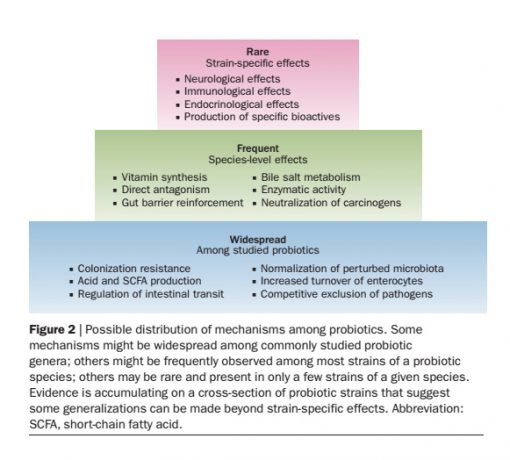Mechanisms of Action
There is a common misconception that probiotics work solely by replacing or “colonizing” the GIT. The reality is that permanent colonization by probiotic bacteria (at least for lactobacilli and bifidobacteria) does not occur and modification of the microbiota is only one of many potential ways that an ingested probiotic strain can influence human health. Once you realize the breadth of potential actions of probiotics, you can start to appreciate their potential value in a broad range of clinical conditions.
Probiotic strains have demonstrated a wide variety of therapeutic effects, which explains why they can be useful for such a diversity of conditions. Such therapeutic actions include:[1]
Anti-inflammatory activity
Modification of GIT transit
Induction of oral tolerance
Reduced visceral hypersensitivity
Competition for gastrointestinal or vaginal adhesion sites
Antagonism against potential pathogens
Induction of GIT mucin secretion
Enhanced GIT IgA secretion
Directly attaching to rotaviruses
GIT microbiota modification
Breastmilk microbiota modification
Vaginal microbiota modification
Production of beneficial compounds (e.g., short chain fatty acids)
Alteration of the vaginal, intestinal and colonic milieu
Strengthening of the intestinal barrier
Repair of the intestinal barrier
Chemopreventative effects
Metabolism of cholesterol in the GIT
This discussion again points to the importance of choosing the correct strain that has the action you are wanting when treating a specific health condition. For example, a constipated patient with a long gut transit time would need a strain that speeds up transit time. Or a patient with vaginal candidiasis would need a strain with proven anti-Candida actions and a capacity to temporarily colonize the vagina.
Unfortunately, no one strain demonstrates all the therapeutic actions highlighted above – they are not a “one strain fits all” or “one supplement fits all” proposition. Hence, clinicians will need to have a number of different probiotic strains at their disposal to accommodate the breadth of presentations they’ll see in practice.
1. Hawrelak, J., Probiotics, in Herbs & Natural Supplements: An Evidence-based Guide. , L.A. Braun and M. Cohen, Editors. 2015, Elsevier: Sydney. p. 771-795.

